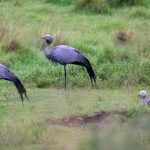Happy Thanksgiving to you and yours from the Core Team. As this holiday is called Turkey Day in a most ironic jab towards the object of American appetites, my initial instinct is to offer up a favored vegetable recipe or some fascinating facts about the Wild Turkey. However, it comes to mind that Meleagris gallopavo is not the only species of turkey that I’ve encountered.
Back in July of 2003, just a few months into our career as birders, Sara and I took an incredible trip to Belize. Our immersion into this avian-rich environment might have been the step that sealed our fates as committed bird watchers. Really, I can’t recommend the journey, or the Maya Mountain Lodge, highly enough. Every day, we embarked on a new adventure; one day we’d explore the ruins of Xunantunich, the next would find us kayaking into the Stygian depths of a pristine cave. One of our favorite excursions was a day trip to the renowned temple complex of Tikal in Guatemala. By the time we took this trip, we’d already been dazzled by a cavalcade of dazzling new birds. Our peerless guide, Luis, one of the most impressive naturalists and amateur archaeologists I’ve ever met, introduced us to exotic new species at every turn. It got to the point that we were somewhat oversaturated. That’s why when I spotted a turkey with prismatic plumage at the front gate to Tikal, I took little notice. In fact, I didn’t even mention the sighting until later, assuming the bird was just a Wild Turkey. However, as we were leaving, after a day filled with monkeys, coatimundi, toucans, oropendola, toucans, and guan, I did think to mention that I noticed a particularly colorful turkey at the entrance.
“Oh yeah,” Luis exclaimed, “That was an Ocellated Turkey.”
“An Ocellated Turkey?”
“That’s right, Pepe (he called everyone Pepe.)”
Imagine my chagrin at realizing that I passed a life bird without alerting my wife and partner-in-crime. Now, imagine my relief when we found the beauteous bird working the grass for seed right where I originally spotted it. At that moment, the Core Team closed out turkeys on our list, accounting for both of the world’s species!
The Ocellated Turkey (Meleagris ocellata) really is a splendid bird, looking like a wondrous hybrid of turkey and peacock. Its feathers share the iridescent sheen of oil on water. Its head is a bright azure crusted with ruby caruncles. Its large rounded tail, considered by some as its most striking feature, is also blue, with green and purple eyespots, from which it’s name is derived (ocelli is Latin for ‘little eye’) and rich bronze or golden tips. These birds sport snoods, but no beards. The ocellated turkey, called Cutz by the Maya, is quite a treat for the eyes. Rumor has it that it’s not so tough on the taste buds either, but that’s of no concern to me.
Ocellated turkeys are noticeably smaller than any of the five subspecies of North American Wild Turkeys, with toms maxing out at 11-12 pounds during breeding season. These omnivorous birds are junglefowl, but avoid the deep jungle by sticking to open spaces and second-growth scrub. The ocellated turkey is restricted to a 50,000 square mile area encompassing Belize, Guatemala, and Mexico’s Yucatan Peninsula, along with limited areas of the states of Tabasco and Chiapas. Last but certainly not least, the species has never been domesticated. Now that’s a wild turkey!











Leave a Comment